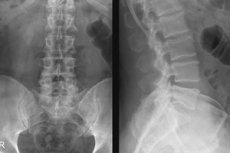X-ray of the lumbosacral spine
Last reviewed: 17.10.2021

All iLive content is medically reviewed or fact checked to ensure as much factual accuracy as possible.
We have strict sourcing guidelines and only link to reputable media sites, academic research institutions and, whenever possible, medically peer reviewed studies. Note that the numbers in parentheses ([1], [2], etc.) are clickable links to these studies.
If you feel that any of our content is inaccurate, out-of-date, or otherwise questionable, please select it and press Ctrl + Enter.

For doctors in traumatology, vertebrology and orthopedics, an X-ray of the lumbosacral spine allows them to diagnose its anatomical abnormalities, injuries and diseases, and then to treat them.
Indications for the procedure
X-ray examination of the lumbosacral - lumbosacral spine is prescribed for patients with pain localized in the vertebrae L1-L5 and S1-S5, in order to find out their cause and confirm or refute: [1]
- fracture or other traumatic injury;
- lumbar hyperlordosis;
- intervertebral hernia;
- arthritis and osteoarthritis;
- osteoarthritis or osteochondrosis;
- displacement of the lumbar vertebrae (spondylolisthesis);
- spondylitis;
- sclerotic and degenerative changes in the vertebrae - spondylosis of the lumbar spine ;
- dysplasia / hypoplasia of the articular processes of the vertebrae;
- ankylosing spondylitis (ankylosing spondylitis);
- deforming spondyloarthrosis (pathology of the facet joints);
- ossification of the ligaments of the spine (idiopathic lumbar hyperostosis),
- scoliosis;
- sacralization or lumbarization of the lumbar and sacral vertebrae.
X-rays are used to monitor the progression of diseases or determine the effectiveness of their treatment, as well as after surgery. [2]
An x-ray of the sacroiliac joints - two sacroiliac joints connecting the sacrum (os sacrum), located below the lumbar spine, with the ilium (ossis ilium) of the pelvis, that is, x-ray of the ileosacral joints of the sacral spine - allows you to find out the cause of pain and stiffness of movements, including: arthrosis and arthritis; inflammatory process (sacroiliitis); degenerative-dystrophic changes in bone structures in osteoporosis. And also to differentiate neurogenic, muscle or somatic pain in the sacrum from vertebrogenic pain syndrome.
Preparation
X-rays of these segments of the spinal column require preparation. Firstly, three days before the examination, it is recommended to stop eating foods that cause flatulence (increased gas formation in the intestines).
Secondly, an enema is done before an X-ray of the lumbosacral spine: bowel cleansing is necessary to obtain better images.
Directly in the X-ray room, the patient must take off everything that is made of metal.
Part of the abdominal region, the mediastinal region, the thyroid gland are protected by lead pads.
Technique of the x-ray of the lumbosacral spine
Standard images of the lumbosacral region and ileosacral joints are taken in frontal and lateral projections. Separately, you may need to take an angle shot (in oblique projection).
The position of the patient for obtaining a frontal (anteroposterior) image - lying on his back or on his stomach (depending on the requirements of the attending physician); for lateral - lying on its side. [3]
In addition, to assess the stability of the spine under physiological stress, a functional X-ray of the lumbosacral spine is performed: photographs are taken in the lateral projection with the patient standing, sitting, bending forward.
Read more in the publication - X - ray of the lower back with functional tests
What an X-ray of the sacral spine shows
In osteoarthritis and osteochondrosis, an X-ray of the sacral spine shows a decrease in the width of the intervertebral fissure - the result of a decrease in the height of the intervertebral disc; displacement and deformation of the processes of the vertebral bodies and the vertebrae themselves; on the side of the vertebrae, bone outgrowths (osteophytes) are observed.
More details in the materials:
- X-ray signs of osteochondrosis
- Diagnostics of the osteochondrosis of the lumbosacral spine
- X-ray signs of bone and joint diseases
With ankylosing spondyloarthritis, the image shows symmetrical changes in the sacroiliac joint: elements of ligament calcification, vertically protruding osteophytes (syndesmophytes). [4]
The presence of an inflammatory process in the ileosacral joints (sacroiliitis) is indicated by the enlargement of the joint space visualized in the picture, the absence of clear contours of the end-plate of the vertebral bone plates and the growth of their bone tissue.
X-ray shows the bone fusion of the last lumbar vertebra (L5) and the first sacral (S1). The state of the L5 vertebra and the absence of fusion of its arch (spondylolysis) is shown in an oblique projection.
Complications after the procedure
There can be no consequences after a single X-ray procedure (with a radiation dose of 0.7 mSv). There are also no complications after the procedure.
It should be borne in mind that each X-ray performed (regardless of which organ is examined) is recorded in the patient's medical record, and the indicator of the cumulative dose of ionizing radiation received within 12 months should not be higher than 1 mSv. So the risks associated with exposure may be associated with exceeding this indicator.

